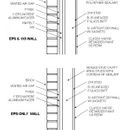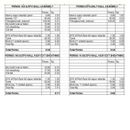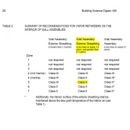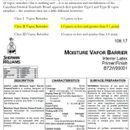Foam too thin – can “rethinking the rules” apply to these walls?
Hello.
Restoring a many-times-remodeled 1950s ranch in zone 5A. The exterior air barrier will be blower door tested before insulation and drywall. The interior air barrier will be tested after the gasketed air-tight drywall is installed.
Existing wall #1 cross section: (detailed cross section attached) 4″ brick, 1″ ventilation gap, 1″ EPS with perforated aluminum facer, 15# felt, 1×6 plank sheathing, fluid applied air barrier (STO Gold Coat w/ fabric over gaps), polyether sealant “ringing the studs”, R-15 unfaced fiberglass batts, 1/2″ airtight gypsum with gaskets, 0.6 perm vapor retarder primer.
Existing wall #2 cross section: (detailed cross section attached) same as wall #1 except delete: the 15# felt, 1×6 plank sheathing, and the Sto fluid applied air barrier. Replace the polyether sealant with Contega HF sealant for “ringing the studs”and sealing them to the EPS to make the air barrier.
I prefer to stay with unfaced batts because they (1) enable better 6-sided cavity contact than faced batts and (2) leave the stud faces available for drywall adhesive as recommended by FHB’s drywall moderator, Myron Ferguson.
I’ve followed the recommendations in Lstiburek, 2006, Understanding Vapor Barriers, (relevant sections attached). Based on the perm calculation (attached) the vapor retarder paint (specification with perm rating attached) seems to meet the requirements in the reference.
My questions:
- Is the perm calculation a reasonable approximation?
- Will these walls “work” with vapor retarder paint in this zone?
- Is vapor retarder paint considered risky in this zone?
- Is an alternative vapor retarder and giving up the 6-sided cavity contact and/or drywall adhesive recommended?
Thank you in advance for any and all comments and criticism.
GBA Detail Library
A collection of one thousand construction details organized by climate and house part













Replies
The drawing doesn't show or specify structural sheathing, nor does your posted stackup description. Is the 1" foil faced EPS going to be the only sheathing and exterior side air barrier?
Vapor retardent paint on the interior is an acceptable vapor retarder for most wall stackups with wood sheathing in US climate zone 5A.
The 1" air gap is sufficient to skip the vapor retardent paint for wood sheathed buildings if your 1" foam is sufficiently vapor permeable. At 1" UNfaced Type 2 EPS is more vapor permeable than CDX or OSB.
Without an ASTM C96 test on the actual foil faced EPS product there is no reasonable way to guess what it's actual permeance will be.
Thank you for the reply.
Only wall #1 has wood 1x6 sheathing. Wall #2 was built later as the walls for an addition in the 80s. It has steel let-in diagonal bracing but no wood structural sheathing, only EPS. It was inspected and approved at the time. Both walls are existing construction and the home is fully bricked. The interior has been gutted and both wall types will get an exterior air barrier from the inside and air tight drywall as described in the drawings.
I used data from a BSC report for the permeability of 1" EPS with a perforated polypropylene facer for the 1" EPS with perforated foil facer on this project.
The current code here requires R-5 foam on the exterior of a 2x4 wall to skip the class II vapor retarder. Am I wrongly interpreting that to mean I need a class II retarder for both of these wall types?
Assuming the perm calculation is correct, will the vapor retarder paint be suitable for both wall types?
Since an ASTM test of the actual material would be prohibitively expensive, can you suggest any sources for obtaining existing perm data for mechanically perforated 1" aluminum foil faced EPS?
Thank you.
Hi Gary -
I am not sure what the purpose of your whole-wall perm calculation is - can you clarify?
Yes, if you skip the exterior rigid insulation, you will need an interior Class II vapor retarder for CZ5.
Can you identify the manufacturer of the perforated foil EPS product? If so, contact them to get the vapor permeability. If not, I think you are fine going with the number from BSC.
Peter
Hi Peter,
I calculated the "wall assembly exterior sheathing" permeability for determining vapor retarder requirements from Table 3 in the Understanding Air Barriers reference shown in my third figure.
I didn't need to calculate the "whole wall assembly" permeability, but did so because of what looks to be a mislabeling ("wall assembly assembly" [sic]) of the third column in Table 3. Apologies for the confusion.
I am stuck with the 1" perforated-foil-faced EPS in these existing walls and don't meet the code-required R-5, so that was my interpretation too, that I needed a class II retarder.
I interpret the data in Table 3 to confirm the need for the class II retarder based on exterior wall sheathing permeability.
EPS is entirely bricked-over and any nomenclature is not visible.
Thanks for your reply.
Gary
I'm starting to understand this better. The EPS is pre-existing, and the sheathed wall is 1x6 plank.
Regarding the EPS on the plank sheathed wall #1:
Was there any sort of interior side vapor retarder (other than the paint)??
Is there any signs if moisture damage on the plank? Have you measured it's moisture content?
I'm not convinced STO on the interior side of plank sheathing would provide adequate air sealing for the plank sheathing.
For the steel braced wall #2: STO should work if you tape any visible seams in the EPS first. The EPS is more than adequate dew point control for the R4-ish framing fraction, and EPS isn't damaged by condensation on the EPS. That wall would probably do just fine without a Class-II vapor retarder, but a smart vapor retarder or vapor barrier latex would be cheap insurance against the batts accumulating moisture/frost over the winter.
Gary,
I'm having a hard time visualizing 1-inch-thick brick (that sounds like a product that is usually glued to a wall) on the exterior side of a ventilation gap.
There are multiple thin brick facade products out there that use a metal support for the brick to allow back-venting channels. It's more common to see it in commercial construction than residential, but these products have been around for awhile:
https://www.kingspan.com/us/en-us/product-groups/architectural-panel-facade-systems/benchmark-facade-systems/thin-brick-facade-system
Thank you Dana.
Should have read: 4" brick, 1" ventilation gap. It is conventional brick: 4" nominal, 3-5/8" actual.
Hopefully I addressed your questions/issues regarding the Sto air barrier system, the MC of the walls, and the old vapor retarder, in the earlier reply to Martin.
May I ask you to please read that reply rather than repeat it here?
You mentioned a vapor barrier latex instead of the vapor retarder latex primer. Of course his would limit the inward drying potential. Would you expand a little on your thinking, please?
Thank you, Dana, for sticking with me on this problem.
Gary
Vapor retardent primer paint is referred to and marketed as "vapor barrier latex". It's the same stuff, about a half-perm when applied to paper faced gypsum board. It's vapor retardency meets Canadian National Building Code definition of "vapour barrier", but being more than 0.1 perms is considered a "Class-II vapor retarder" by IRC definitions.
Half perm paint limits the drying rate, but also limits the wintertime moisture accumulation rate to fairly safe levels if the wallboard is air tight. Even with the reduced drying rate, in a zone 5 location the drying season is ample for purging the wintertime uptake as well as anything that makes it through the perforated faced EPS in the wettest most humid parts of the summer.
Sorry Martin. That should read: brick, 1" ventilation gap.
It is conventional brick: 4" nominal, 3-5/8" actual.
I read your reference on the Sto and Dupont fluid air barriers,
https://www.greenbuildingadvisor.com/article/housewrap-in-a-can-liquid-applied-wrbs
and the GBA blog:
https://www.greenbuildingadvisor.com/article/buttoned-up-for-a-new-century
The blog describes the use of Sto products after spray foam failed to provide an adequate air seal.
As you know, the Sto air barrier is quite tedious, requires spotting defects larger than 1/32" with their filler product, filling gaps between the 1x6s larger than 1/8" with can foam (per the data sheet), applying Sto fabric over the 1x6 gaps, then a final coat of Sto Gold over everything. I've evaluated it in a test stud bay and visually it looks very good. Not blower door tested though.
Also as you know, the Sto system is not manufacturer approved over any type of foam sheet goods, so the wall type #2 air barrier will be implemented by sealing the EPS to the studs, and any defects repaired, using the Pro Clima Profil/Vana Tescon tape and Contega sealant. I have tested these products on EPS and wood and they both appear to adhere well. Not sure if the disappointing performance of the Tescon tapes in your backyard tape test used EPS or XPS. No slick surface on my EPS as you mentioned for XPS in your Sto reference.
The studs and 1x6 in these gutted walls all test at less than 15% MC. The old R-11 kraft faced fiberglass batts were blackened in spots by air leakage. I have considered the use of R-15 kraft faced batts, Certainteed's Smart Batts, and the several SVRs available in roll form.
Perhaps I am misguided, but I prefer an air retarder primer if possible. It enables good 6-sided cavity contact by the insulation and makes the stud faces available for drywall attachment with adhesive. Of course these last two advantages are secondary to getting these old walls to perform properly, from a long term durability perspective, in zone 5.
My very simple-minded approach estimated the exterior wall sheathing assembly permeability for these wall types, looked up the air retarder recommendations in Table 3 shown in the previous attachments, and determined a class II vapor retarder was needed. The Sherwin Williams vapor retarder primer met the class II requirement.
Of course, nothing is that simple, especially in building science, hence this loquacious request for a sanity check.
I also find the new "rethinking" on thin foam:
https://www.greenbuildingadvisor.com/article/rethinking-the-rules-on-minimum-foam-thickness
to be rather confusing, but perhaps good air barriers can help make these walls work as well.
With that being said, I value your response to my initial questions, repeated below for your convenience.
My questions:
5. Is the perm calculation a reasonable approximation?
6. Will these walls "work" with vapor retarder paint in this zone?
7. Is vapor retarder paint considered risky in this zone?
8. Is an alternative vapor retarder and giving up the 6-sided cavity contact and/or drywall adhesive recommended?
Any other comments and criticism are also of course appreciated.
Thank you, Martin
Gary